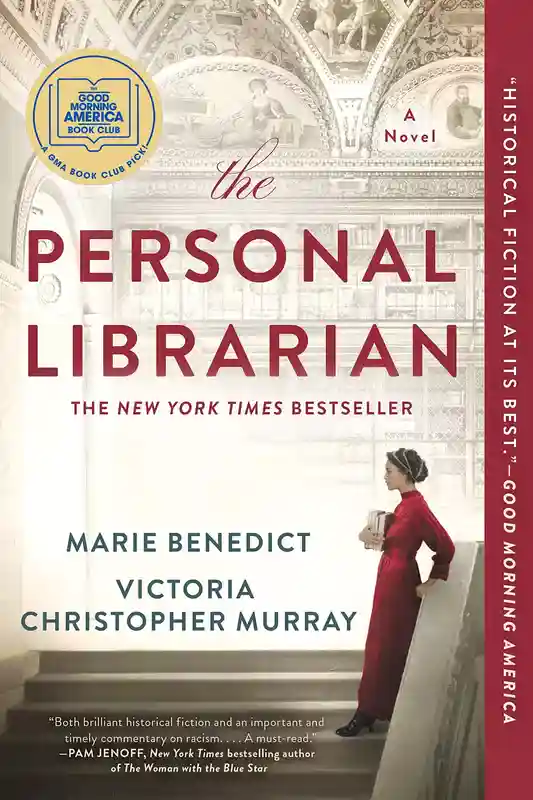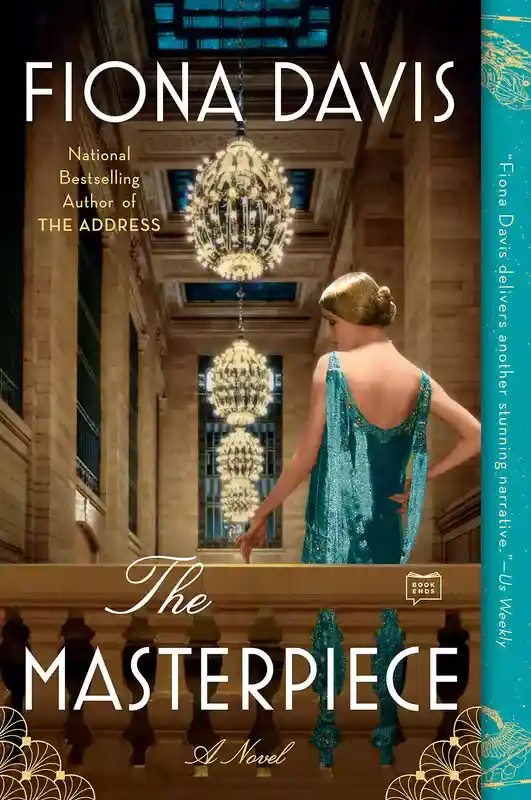This post may contain affiliate links. Read more here.
Book club questions for The Magnolia Palace by Fiona Davis delves into the complexities of power, privilege, and family dynamics in the Gilded Age of New York City.
The novel follows the intertwined lives of Lillian Carter and Veronica Weber as they navigate the world of art and high society, uncovering secrets and betrayals that have been buried for decades. As the story unfolds, readers are faced with thought-provoking questions about the nature of truth, the price of ambition, and the role of fate in our lives.
Plot Summary
Book Club Questions
Characters List
Quotes
This is a gripping tale of secrets and scandal, with richly developed characters and a powerful message that will resonate long after the last page is turned. The Magnolia Palace is a New York Times Bestseller and has received numerous accolades, including being a “People’s Book of the Week.”, and named as one of the best books of 2022.
The novel’s exploration of power and greed in the Gilded Age will make readers reflect on their own experiences and the impact of wealth and privilege on society. It’s a page-turner that will keep you hooked till the very end. The combination of mystery, scandal and a heart-wrenching story makes it a must-read for book clubs and literature enthusiasts alike.
Below, I have written my discussion guide for The Magnolia Palace the detailed synopsis of the book, as well as 14 original book club questions to discuss for your book clubs. Also, don’t forget to read my book recommendations below the questions!
I hope you will enjoy discussing my book club discussion questions for The Magnolia Palace! Have fun analyzing the themes of the story with your book clubs, and let me know what are your thoughts!
The Synopsis
Fiona Davis, New York Times bestselling author of The Lions of Fifth Avenue, returns with a tantalizing novel about the secrets, betrayal, and murder within one of New York City’s most impressive Gilded Age mansions.
Eight months since losing her mother in the Spanish flu outbreak of 1919, twenty-one-year-old Lillian Carter’s life has completely fallen apart. For the past six years, under the moniker Angelica, Lillian was one of the most sought-after artists’ models in New York City, with statues based on her figure gracing landmarks from the Plaza Hotel to the Brooklyn Bridge. But with her mother gone, a grieving Lillian is rudderless and desperate—the work has dried up and a looming scandal has left her entirely without a safe haven. So when she stumbles upon an employment opportunity at the Frick mansion—a building that, ironically, bears her own visage—Lillian jumps at the chance. But the longer she works as a private secretary to the imperious and demanding Helen Frick, the daughter and heiress of industrialist and art patron Henry Clay Frick, the more deeply her life gets intertwined with that of the family—pulling her into a tangled web of romantic trysts, stolen jewels, and family drama that runs so deep, the stakes just may be life or death.
Nearly fifty years later, mod English model Veronica Weber has her own chance to make her career—and with it, earn the money she needs to support her family back home—within the walls of the former Frick residence, now converted into one of New York City’s most impressive museums. But when she—along with a charming intern/budding art curator named Joshua—is dismissed from the Vogue shoot taking place at the Frick Collection, she chances upon a series of hidden messages in the museum: messages that will lead her and Joshua on a hunt that could not only solve Veronica’s financial woes, but could finally reveal the truth behind a decades-old murder in the infamous Frick family.
In love with literature? Try audio books or writing classes
for free for 30 days.✨
Book Club Questions for The Magnolia Palace
The following book club questions have been tailored to this book’s specific reading experience.✨
1. If you could meet any of these characters and have a conversation with them, who would it be? What would your conversation be about?
2. When Miss Helen meets Lillian, she says, “I like to make things difficult for other people. You should know that right off: I’m known to be difficult.” How does their relationship evolve over the course of the book?
3. While trying to convince Lillian to pose for his statues, Mr. Konti says that if the people of New York “walk by one of my statues and look up and see something beautiful, an idea or person who inspires them, then I have done my job. I do this not for me. It’s for humanity.” What do you think of this statement? Does it resonate with you and the role public art plays in your life? Why or why not?
4. Miss Helen seems disconnected from reality, and is frequently oblivious to the feelings and motives of those around her. Why do you think that is? How do you think her wealth and position have altered her worldview? How did it affect the way she treated people like Lillian, or the way her father regarded people like Bertha?
5. How do Joshua’s experiences as a Black man in the art world affect the way he views the art at the Frick? Do his experiences alter your views of art history in any way?
6. How do Lillian’s and Veronica’s experiences working as models in two different decades compare? In what ways does the novel explore the difference between being looked at versus being seen?
7. The tenuous friendship Joshua and Veronica build during their stay in the Frick Collection is almost destroyed when Veronica betrays his trust. What are the stakes for each of them in that moment? What makes Veronica’s actions dangerous for both, and how do their situations differ? What would you have encouraged Veronica to do with her find?
8. Did the ending surprise you? How do you think the truth of what really happened to Henry Clay Frick and the Magnolia diamond affected the different characters at the end?
9. If you could go back in time to one of the eras Fiona Davis writes about in THE MAGNOLIA PALACE, would you? Which would you choose?
Bonus Book Club Questions for The Magnolia Palace
These are my bonus book club questions that take a different approach on analyzing certain themes of the book.
10. The novel explores the theme of identity, with Lillian and Veronica both struggling to find their place in the world. How do their experiences and the challenges they face reflect larger societal issues of the time? How do their journeys of self-discovery relate to your own experiences of finding your identity?
11. The novel also touches on themes of power and privilege, with characters like Helen Frick and Mr. Konti using their wealth and status to exert control over others. How does the novel depict the ways in which power can be used for both good and bad? How does it challenge the idea that wealth and privilege automatically lead to happiness and fulfillment?
12. The characters are forced to confront their pasts and the secrets they have been keeping. How does the novel explore the idea of secrets and the ways in which they can shape and affect our lives? How do the characters’ secrets ultimately impact the events of the story?
13. The novel also explores the theme of art and how it can be used to express ideas and emotions. How does the novel depict the role of art in society and the ways in which it can shape cultural norms? How does it challenge the idea of art as a luxury item for the wealthy elite?
14. The novel spans two different eras, the 1920s and the 1970s. How does the novel use these two time periods to explore the ways in which society has changed, and the ways in which certain issues and themes remain the same? How does it use the contrast between the two eras to comment on the nature of progress and societal evolution?
Additional Recommendations
Hope you enjoyed these original book club and discussion questions for The Magnolia Palace by Fiona Davis!
Here are some more of my book club recommendations:
The Personal Librarian by Marie Benedict
and Victoria C. Murray
A remarkable novel about J. P. Morgan’s personal librarian, Belle da Costa Greene, the Black American woman who was forced to hide her true identity and pass as white in order to leave a lasting legacy that enriched our nation, from New York Times bestselling authors Marie Benedict and Victoria Christopher Murray.
In her twenties, Belle da Costa Greene is hired by J. P. Morgan to curate a collection of rare manuscripts, books, and artwork for his newly built Pierpont Morgan Library. Belle becomes a fixture in New York City society and one of the most powerful people in the art and book world, known for her impeccable taste and shrewd negotiating for critical works as she helps create a world-class collection.
But Belle has a secret, one she must protect at all costs. She was born not Belle da Costa Greene but Belle Marion Greener. She is the daughter of Richard Greener, the first Black graduate of Harvard and a well-known advocate for equality. Belle’s complexion isn’t dark because of her alleged Portuguese heritage that lets her pass as white—her complexion is dark because she is African American.
The Personal Librarian tells the story of an extraordinary woman, famous for her intellect, style, and wit, and shares the lengths she must go to—for the protection of her family and her legacy—to preserve her carefully crafted white identity in the racist world in which she lives.
The Masterpiece by Fiona Davis
For most New Yorkers, Grand Central Terminal is a crown jewel, a masterpiece of design. But for Clara Darden and Virginia Clay, it represents something quite different.
For Clara, the terminal is the stepping stone to her future. It is 1928, and Clara is teaching at the lauded Grand Central School of Art. Though not even the prestige of the school can override the public’s disdain for a “woman artist,” fiery Clara is single-minded in her quest to achieve every creative success—even while juggling the affections of two very different men. But she and her bohemian friends have no idea that they’ll soon be blindsided by the looming Great Depression…and that even poverty and hunger will do little to prepare Clara for the greater tragedy yet to come.
By 1974, the terminal has declined almost as sharply as Virginia Clay’s life. Dilapidated and dangerous, Grand Central is at the center of a fierce lawsuit: Is the once-grand building a landmark to be preserved, or a cancer to be demolished? For Virginia, it is simply her last resort. Recently divorced, she has just accepted a job in the information booth in order to support herself and her college-age daughter, Ruby. But when Virginia stumbles upon an abandoned art school within the terminal and discovers a striking watercolor, her eyes are opened to the elegance beneath the decay. She embarks on a quest to find the artist of the unsigned masterpiece—an impassioned chase that draws Virginia not only into the battle to save Grand Central but deep into the mystery of Clara Darden, the famed 1920s illustrator who disappeared from history in 1931.
Thank you for reading my book club questions and as always, happy reading! ❤️

